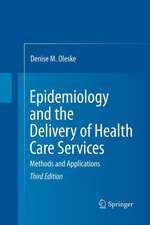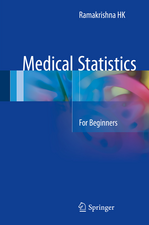The Statistical Analysis of Recurrent Events: Statistics for Biology and Health
Autor Richard J. Cook, Jerald Lawlessen Limba Engleză Hardback – 2 aug 2007
More general intensity-based models are also considered, as well as simpler models that focus on rate or mean functions. Parametric, nonparametric and semiparametric methodologies are all covered, with clear descriptions of procedures for estimation, testing and model checking. Important practical topics such as observation schemes and selection of individuals for study, the planning of randomized experiments, events of several types, and the prediction of future events are considered.
Methods of modeling and analysis are illustrated through many examples taken from health research and industry. The objectives and interpretations of different analyses are discussed in detail, and issues of robustness are addressed. Statistical analysis of the examples is carried out with S-PLUS software and code is given for some examples.
This book is directed at graduate students, researchers, and applied statisticians working in industry, government or academia. Some familiarity with survival analysis is beneficial since survival software is used to carry out many of the analyses considered. This book can be used as a textbook for a graduate course on the analysis of recurrent events or as a reference for a more general course on event history analysis. Problems are given at the end of chapters to reinforce the material presented and to provide additional background or extensions to certain topics.
| Toate formatele și edițiile | Preț | Express |
|---|---|---|
| Paperback (1) | 849.02 lei 6-8 săpt. | |
| Springer – 23 noi 2010 | 849.02 lei 6-8 săpt. | |
| Hardback (1) | 1169.22 lei 6-8 săpt. | |
| Springer – 2 aug 2007 | 1169.22 lei 6-8 săpt. |
Din seria Statistics for Biology and Health
- 20%
 Preț: 633.23 lei
Preț: 633.23 lei - 17%
 Preț: 352.01 lei
Preț: 352.01 lei - 20%
 Preț: 776.71 lei
Preț: 776.71 lei - 20%
 Preț: 1376.32 lei
Preț: 1376.32 lei - 18%
 Preț: 1394.84 lei
Preț: 1394.84 lei - 18%
 Preț: 883.59 lei
Preț: 883.59 lei - 5%
 Preț: 843.91 lei
Preț: 843.91 lei -
 Preț: 397.16 lei
Preț: 397.16 lei - 20%
 Preț: 1002.67 lei
Preț: 1002.67 lei - 18%
 Preț: 1395.32 lei
Preț: 1395.32 lei - 5%
 Preț: 1102.10 lei
Preț: 1102.10 lei - 5%
 Preț: 874.83 lei
Preț: 874.83 lei - 15%
 Preț: 657.39 lei
Preț: 657.39 lei - 18%
 Preț: 960.93 lei
Preț: 960.93 lei - 15%
 Preț: 585.90 lei
Preț: 585.90 lei - 5%
 Preț: 852.69 lei
Preț: 852.69 lei - 18%
 Preț: 903.62 lei
Preț: 903.62 lei - 5%
 Preț: 721.40 lei
Preț: 721.40 lei - 15%
 Preț: 653.46 lei
Preț: 653.46 lei - 18%
 Preț: 2114.90 lei
Preț: 2114.90 lei - 18%
 Preț: 1108.99 lei
Preț: 1108.99 lei - 5%
 Preț: 821.39 lei
Preț: 821.39 lei - 5%
 Preț: 849.02 lei
Preț: 849.02 lei - 15%
 Preț: 653.14 lei
Preț: 653.14 lei - 18%
 Preț: 958.56 lei
Preț: 958.56 lei - 5%
 Preț: 722.69 lei
Preț: 722.69 lei - 18%
 Preț: 728.74 lei
Preț: 728.74 lei - 18%
 Preț: 943.22 lei
Preț: 943.22 lei - 5%
 Preț: 1092.43 lei
Preț: 1092.43 lei - 15%
 Preț: 594.21 lei
Preț: 594.21 lei - 5%
 Preț: 377.87 lei
Preț: 377.87 lei - 18%
 Preț: 1124.60 lei
Preț: 1124.60 lei - 18%
 Preț: 1220.12 lei
Preț: 1220.12 lei - 15%
 Preț: 632.98 lei
Preț: 632.98 lei - 18%
 Preț: 1394.84 lei
Preț: 1394.84 lei -
 Preț: 389.11 lei
Preț: 389.11 lei - 18%
 Preț: 959.98 lei
Preț: 959.98 lei
Preț: 1169.22 lei
Preț vechi: 1230.76 lei
-5% Nou
Puncte Express: 1754
Preț estimativ în valută:
223.72€ • 234.22$ • 185.12£
223.72€ • 234.22$ • 185.12£
Carte tipărită la comandă
Livrare economică 05-19 aprilie
Preluare comenzi: 021 569.72.76
Specificații
ISBN-13: 9780387698090
ISBN-10: 0387698094
Pagini: 403
Ilustrații: XX, 404 p.
Dimensiuni: 155 x 235 x 24 mm
Greutate: 0.71 kg
Ediția:2007
Editura: Springer
Colecția Springer
Seria Statistics for Biology and Health
Locul publicării:New York, NY, United States
ISBN-10: 0387698094
Pagini: 403
Ilustrații: XX, 404 p.
Dimensiuni: 155 x 235 x 24 mm
Greutate: 0.71 kg
Ediția:2007
Editura: Springer
Colecția Springer
Seria Statistics for Biology and Health
Locul publicării:New York, NY, United States
Public țintă
Professional/practitionerCuprins
Models and Frameworks for Analysis of Recurrent Events.- Methods Based on Counts and Rate Functions.- Analysis of Gap Times.- General Intensity-Based Models.- Multitype Recurrent Events.- Observation Schemes Giving Incomplete or Selective Data.- OtherTopics.
Recenzii
From the Reviews:
"The book provides many good real life examples to demonstrate application of the methods discussed....[it] is excellent for teaching an advanced class in statistics on this topic as it also contains many good exercises at the end of each chapter, some being extensions of the discussions." (Journal of Biopharmaceutical Statistics (JBS), Issue #5, 2008)
"This book provides a timely and comprehensive review of methodologies for recurrent event data analysis and should be beneficial to Biometrics readers who are interested in recurrent events."
"The strength of this book is its scope. It covers most of the methodology that is readily available for general use. ...Overall, we think this is a very good reference for recurrent event data analysis, especially because no other books provide a similar degree of coverage, and it would provide a nice textbook for a graduate-level course on the topic." (Biometrics, September 2008)
"This book deals with processes generating multiple events over time. … The book comprises eight chapters, four appendices and a useful notational glossary. … it is directed to a much broader target readership, like social scientists, economists and industrial statisticians as well. … Many examples are used to illustrate and discuss the models and statistical methods in great detail. Techniques for estimation, testing and model checking are lucidly described … for a graduate course." (Harald Heinzl, Zentralblatt MATH, Vol. 1159, 2009)
“…Every aspiring statistical researcher interested in recurrent events should have this book on his/her shelf as a great guide for learning the state-of-the-art stochastic models, frequentist (mostly estimating equation and asymptotic based) methods, and computational tools (including popular programs and routines). This is a very well-organized and comprehensive book on a very rapidly expanding area ofresearch. As a mentor of PhD students, I myself will definitely recommend every graduate student interested in mastering recurrent events to read this book thoroughly to understand the current state of the literature as well as areas of future research and further development.” ( Journal of the American Statistical Association, Dec. 2009, Vol. 104, No. 488)
"The book provides many good real life examples to demonstrate application of the methods discussed....[it] is excellent for teaching an advanced class in statistics on this topic as it also contains many good exercises at the end of each chapter, some being extensions of the discussions." (Journal of Biopharmaceutical Statistics (JBS), Issue #5, 2008)
"This book provides a timely and comprehensive review of methodologies for recurrent event data analysis and should be beneficial to Biometrics readers who are interested in recurrent events."
"The strength of this book is its scope. It covers most of the methodology that is readily available for general use. ...Overall, we think this is a very good reference for recurrent event data analysis, especially because no other books provide a similar degree of coverage, and it would provide a nice textbook for a graduate-level course on the topic." (Biometrics, September 2008)
"This book deals with processes generating multiple events over time. … The book comprises eight chapters, four appendices and a useful notational glossary. … it is directed to a much broader target readership, like social scientists, economists and industrial statisticians as well. … Many examples are used to illustrate and discuss the models and statistical methods in great detail. Techniques for estimation, testing and model checking are lucidly described … for a graduate course." (Harald Heinzl, Zentralblatt MATH, Vol. 1159, 2009)
“…Every aspiring statistical researcher interested in recurrent events should have this book on his/her shelf as a great guide for learning the state-of-the-art stochastic models, frequentist (mostly estimating equation and asymptotic based) methods, and computational tools (including popular programs and routines). This is a very well-organized and comprehensive book on a very rapidly expanding area ofresearch. As a mentor of PhD students, I myself will definitely recommend every graduate student interested in mastering recurrent events to read this book thoroughly to understand the current state of the literature as well as areas of future research and further development.” ( Journal of the American Statistical Association, Dec. 2009, Vol. 104, No. 488)
Textul de pe ultima copertă
Recurrent event data arise in diverse fields such as medicine, public health, insurance, social science, economics, manufacturing and reliability. The purpose of this book is to present models and statistical methods for the analysis of recurrent event data. No single comprehensive treatment of these areas currently exists. The authors provide broad but detailed coverage of the major approaches to analysis, while also emphasizing the modeling assumptions that they are based on. Thus, they consider important models such as Poisson and renewal processes, with extensions to incorporate covariates or random effects.
More general intensity-based models are also considered, as well as simpler models that focus on rate or mean functions. Parametric, nonparametric and semiparametric methodologies are all covered, with clear descriptions of procedures for estimation, testing and model checking. Important practical topics such as observation schemes and selection of individuals for study, the planning of randomized experiments, events of several types, and the prediction of future events are considered.
Methods of modeling and analysis are illustrated through many examples taken from health research and industry. The objectives and interpretations of different analyses are discussed in detail, and issues of robustness are addressed. Statistical analysis of the examples is carried out with S-PLUS software and code is given for some examples.
This book is directed at graduate students, researchers, and applied statisticians working in industry, government or academia. Some familiarity with survival analysis is beneficial since survival software is used to carry out many of the analyses considered. This book can be used as a textbook for a graduate course on the analysis of recurrent events or as a reference for a more general course on event history analysis. Problems are given at the end of chapters to reinforce the material presented and to provide additional background or extensions to certain topics.
Richard J. Cook is Professor in the Department of Statistics and Actuarial Science at the University of Waterloo and Canada Research Chair in Statistical Methods for Health Research. He is an Associate Editor for Lifetime Data Analysis.
Jerald F. Lawless is Professor in the Department of Statistics and Actuarial Science at the University of Waterloo. He is a former Editor of Technometrics and from 1994-2004 held the General Motors Canada-NSERC Industrial Research Chair in Quality and Productivity. He is the author of Statistical Models and Methods for Lifetime Data, Second Edition (2003).
More general intensity-based models are also considered, as well as simpler models that focus on rate or mean functions. Parametric, nonparametric and semiparametric methodologies are all covered, with clear descriptions of procedures for estimation, testing and model checking. Important practical topics such as observation schemes and selection of individuals for study, the planning of randomized experiments, events of several types, and the prediction of future events are considered.
Methods of modeling and analysis are illustrated through many examples taken from health research and industry. The objectives and interpretations of different analyses are discussed in detail, and issues of robustness are addressed. Statistical analysis of the examples is carried out with S-PLUS software and code is given for some examples.
This book is directed at graduate students, researchers, and applied statisticians working in industry, government or academia. Some familiarity with survival analysis is beneficial since survival software is used to carry out many of the analyses considered. This book can be used as a textbook for a graduate course on the analysis of recurrent events or as a reference for a more general course on event history analysis. Problems are given at the end of chapters to reinforce the material presented and to provide additional background or extensions to certain topics.
Richard J. Cook is Professor in the Department of Statistics and Actuarial Science at the University of Waterloo and Canada Research Chair in Statistical Methods for Health Research. He is an Associate Editor for Lifetime Data Analysis.
Jerald F. Lawless is Professor in the Department of Statistics and Actuarial Science at the University of Waterloo. He is a former Editor of Technometrics and from 1994-2004 held the General Motors Canada-NSERC Industrial Research Chair in Quality and Productivity. He is the author of Statistical Models and Methods for Lifetime Data, Second Edition (2003).
Caracteristici
Provides an extensive discussion of the wide range of models and methods that are available to researchers and practitioners faced with the design and analysis of studies involving recurrent events














